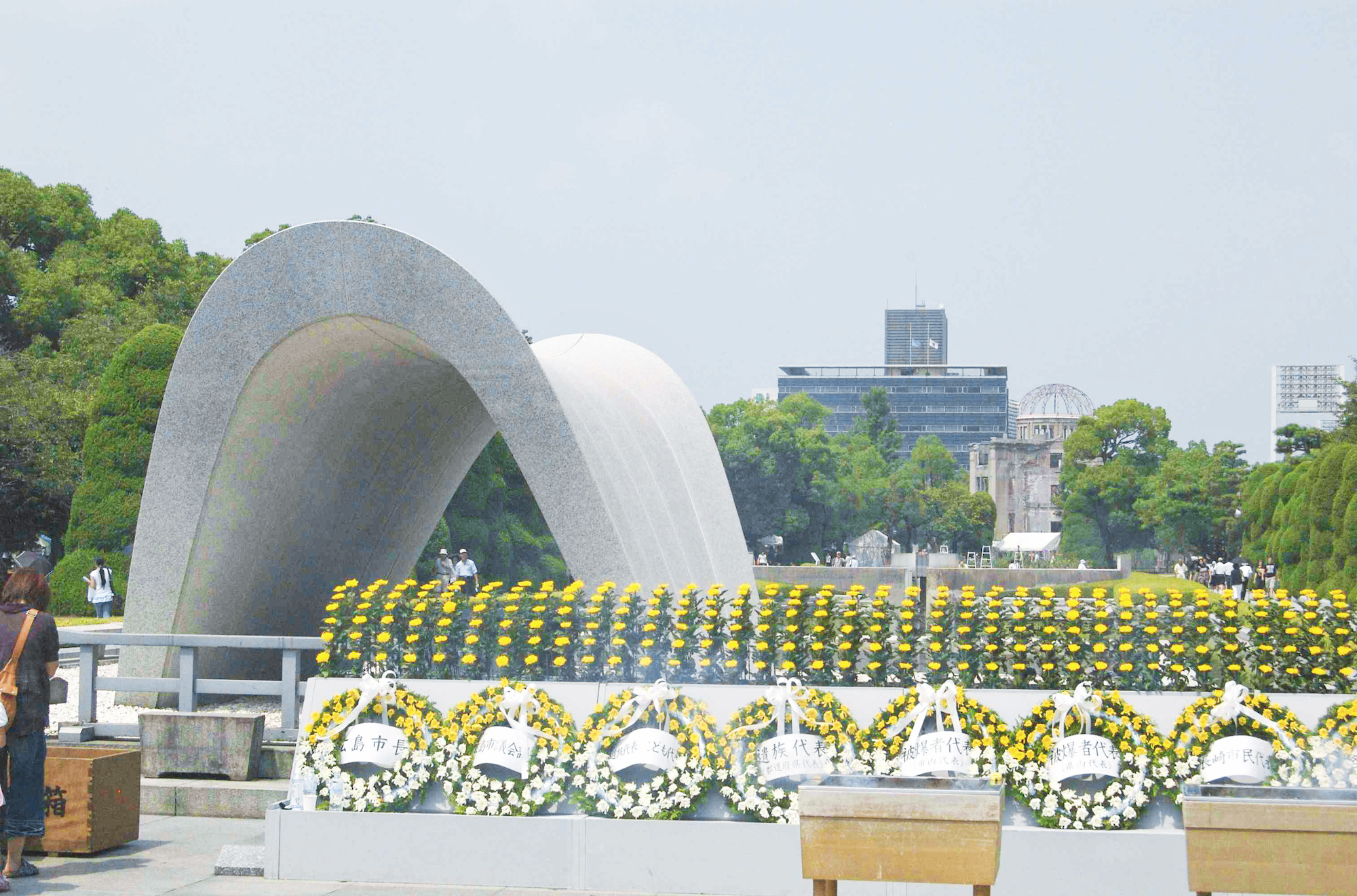The Eternal Flame Dome (Photo: Courtesy of Rob Buscher)
A descendant of the town devastated by the A-bomb, the writer gives hope for a world without nuclear weapons.
By Rob Buscher, Contributor
Since the end of World War II, the United States has served as de facto leader of a world order characterized by international cooperation and global commerce. However, at a time when disease runs rampant throughout most of the country without any clear plan for curtailing the current COVID-19 pandemic, the U.S. has seemingly vacated its status as world leader.
America has faced similar crises in the past, yet this moment seems different. Perhaps in part because the failure of leadership related to the pandemic is simultaneously occurring amid a society-wide reckoning related to racial equity that the murder of George Floyd has brought about.
These circumstances have thrust us into an unparalleled crisis as many Americans find themselves questioning their faith in our institutions of democracy and revisiting controversial aspects of our nation’s past with a critical eye.
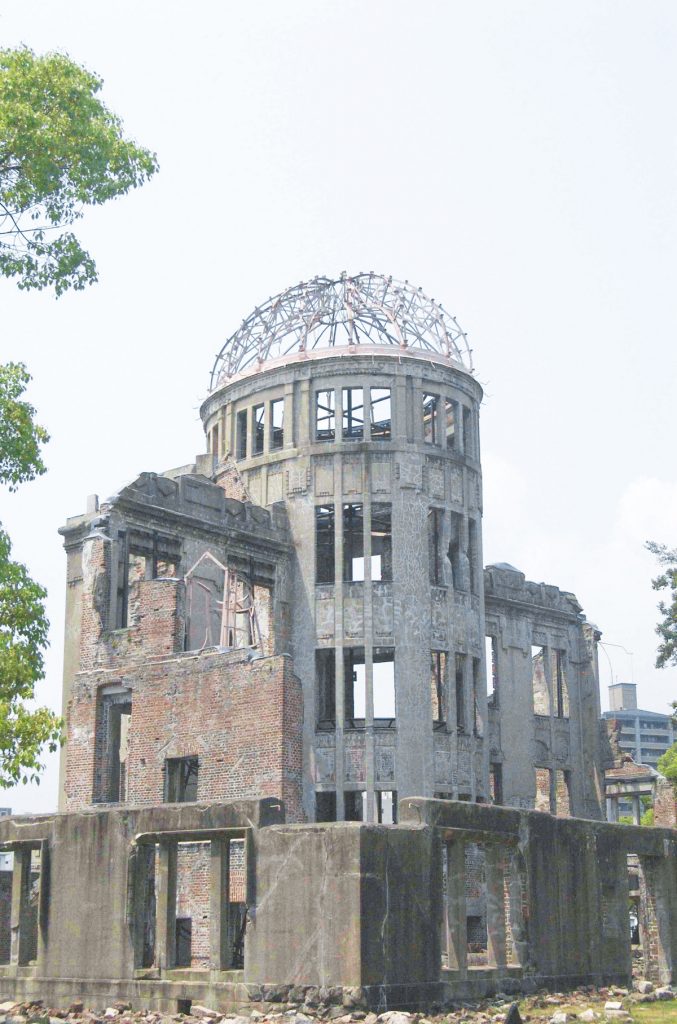
The A-bomb Dome in Hiroshima (Photo: Courtesy of Rob Buscher)
It is in this unique moment that we commemorate the 75th anniversary of the atomic bombings of Hiroshima and Nagasaki on Aug. 6 and 9, 1945, respectively. War is terrible, and people on all sides of any conflict commit atrocities. However, it is possible, and even necessary, for us to interrogate the extraordinary cruelty and blatant disregard for human life that the atomic bombings represent if we are to guarantee that they are never again used in war.
Nuclear weapons are far too dangerous for any country to possess, and they have the potential to leave ruinous environmental impacts for generations to come. To put this in perspective, approximately 240,000 people died from the atomic bombings on Hiroshima and Nagasaki and radiation-related illness — twice the total population of Japanese Americans who were incarcerated during WWII. Elders, men, women and children — noncombatants who were going about their daily business in their civilian lives all perished.
Ron Kuramoto of the Pacific Citizen Editorial Board recently wrote an op-ed titled “No More Gaman!” that espoused the need for Japanese Americans to speak up about current-day injustices. I believe it is also necessary for us to apply this sentiment to historical injustices and no longer accept the government narrative that the atomic bombings were a necessary evil.
History tends to be remembered not only from the perspective of the victor, but also in absolutes. In U.S. public education, we have been taught only one perspective on the closing chapter of WWII. To fully understand the enormity of this event, it is necessary to delve into the atomic bombings with greater nuance.
The conventional narrative according to U.S. history books is that the atomic bombings were needed to bring a decisive end to the war and avoid the loss of further lives in a ground invasion of Japan. While the appallingly high civilian casualties during the Battle of Okinawa is often cited as a motivation for the atomic bombs, the reality is far more political in nature.
By the week of Aug. 6, 1945, the Soviet Union was days away from invading the Northern Japanese Island of Hokkaido. Wishing to avoid a divided occupation similar to East and West Germany, the U.S. needed to expedite the end of the war, positioning itself as the sole victor.
Demonstrating the horrific destructive power that the U.S. now possessed in its atomic arsenal, the bomb also set a tone of American dominance in postwar U.S.-Soviet relations. A more cynical view point of the bombing would suggest that in addition to the political gains, the scientific community also wanted to study the impact of the bombs on live subjects.
Despite even the worst genocidal crimes of the Nazi regime, it is difficult to imagine the American public accepting a weapon of this magnitude being used in the European front of the war. Undeniably, race is an important factor in this distinction, and the impact of highly racialized anti-Japanese propaganda is clearly evident.
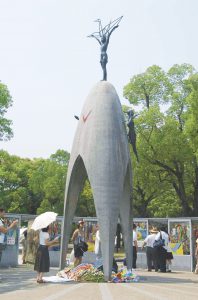
The Children’s Peace Monument commemorates Sadako Sasaki and all child victims of the Hiroshima bombing. (Photo: Courtesy of Rob Buscher)
Growing numbers of legal experts are now arguing that the atomic bombings would be considered war crimes by today’s standards. Article 147 of the 1949 Geneva Convention defines a war crime perpetrated against a noncombatant civilian as “wilful killing, torture or inhuman treatment, including biological experiments, wilfully causing great suffering or serious injury to body or health … and extensive destruction and appropriation of property, not justified by military necessity and carried out unlawfully and wantonly.”
The atomic bombings appear to fit that definition, as it is indisputable that the U.S. military knowingly killed civilians without reasonable effort to notify them of imminent danger. This is an important distinction, as even the deadly Tokyo firebombing campaign (which killed more people in a single night than either the bombing of Hiroshima or Nagasaki) was preceded by an airborne leaflet drop warning civilians to vacate the city.
Imperial Japan also inflicted countless atrocities throughout its conquest of Asia but was ultimately subject to war crimes trials in the postwar era. Revisiting the atomic bombings as a potential war crime shatters the unassailable image of the U.S. military as “the good guy” during WWII — like much of the Japanese American narrative in general.
Openly discussing these subjects still carries a deep taboo — one that often results in emotionally charged knee-jerk responses that revert to propaganda narratives justifying the bombing as a military necessity.
An additional burden that might keep the Japanese American community from taking a more critical stance on this issue is the political reality that much of our community’s privileges and upward social mobility in the postwar era is thanks to the valor and unimaginable sacrifices of our Nisei veterans.
I would argue however, that it is possible to criticize the military’s role in this atrocity while also celebrating the good deeds of our soldiers.
In Japan, the taboo surrounding open discussion of the atomic bombings runs even deeper, largely related to the stigmatization that hibakusha (atomic bomb survivors) and their descendants have faced in Japanese society.
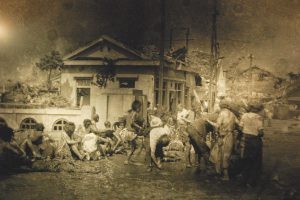
Hibakusha in Hiroshima following the bombing (Photo: Courtesy of Rob Buscher)
Early in the postwar era, some hibakusha were denied housing or jobs over erroneous concerns related to the transmission of radiation-related diseases. Hibakusha and their descendants were also generally viewed as unsuitable marriage prospects by families outside the region for fear of birth defects. Even today, it is not uncommon for individuals to change their name or obscure their family origins if they move outside the region.
The trauma of being the only country in the world to have witnessed the horror of atomic warfare is said to persist as a nuclear stigma in the Japanese psyche. In commemorating this grim anniversary, I wonder to what extent this also translates into the Japanese American community as I consider the impact on my own family.
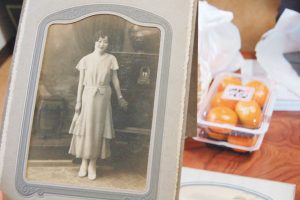
Rob Buscher’s hibaachan, Asako Marumoto, in a 1927 photo (Photo: Courtesy of Rob Buscher)
My great-grandmother, Asako Marumoto, or hibaachan as I called her, lived in Hiroshima from ages 5-18. Born to Issei plantation workers in Hilo, Hawaii, hibaachan was sent to live with her maternal grandparents in Hiroshima so that she could experience a traditional Japanese upbringing.
There, she was raised in a multigenerational household by her mother’s brother and his wife. She named their first two children — one died in the bombing while working as a teller in a downtown bank; the other survived with minor injuries, protected from the blast radius by Higashiyama, a small hill that stood between the city and the suburban neighborhood where our family home is located.
Another cousin perished while she was clearing out debris and trash from the city center with her classmates so there would be less fuel to burn in the eventuality of firebombing that had wracked other Japanese cities since March 1945. When the family went looking for her, all they found was her metal bento box.
I have often wondered what those initial moments must have been like when my great-grandparents learned of the destruction of their hometown. I asked my obaachan, Yukari Mikesell, whether she remembered that moment.
She responded, “We all seem to have not been close by our parents at that time. I know Mother was worried, but there was nothing they could do about it … shikata ga nai. I do remember when we learned the war was over. Sirens were going off all around as we left the orchard. Mom and Dad were sad and shook their heads and said that Japan did not know the might and supplies that the Americans had. What a foolish thing it was to go to war with America.”
She also remembers her mother moving listlessly through her days in a near-catatonic state for weeks as she tried to cope with the assumption that everyone she knew and loved in Hiroshima was dead.
News about her family finally reached hibaachan about a month later in September 1945. Mourning the deaths of her cousins, hibaachan saved what little money she could from our family’s sharecropping work and her side job as a domestic worker to send food, textiles and other materials to her surviving relatives in Japan.
“We sacrificed a lot to make sure that we sent things to help our relatives out,” Mikesell recalled. “We did without. We went to the store and bought large-size food products like sacks of rice and even boxes of Hershey’s bars to send. Mother used to talk about the fact that her own children wore tight clothes and shoes because of the cost of sending things overseas.”
In the 18 years I knew her, hibaachan was enigmatic to me for a number of reasons as an elderly woman with limited English proficiency who had lived a lifetime of hardship before I was born.
Sent an ocean away from her family as a young child, after graduating high school, she married a man who was virtually a stranger and moved to California, where they toiled in a substandard plot of leased land until Pearl Harbor happened, then fled to Utah during the so-called voluntary evacuation so their children would not grow up behind barbed-wire fences.
Her life story was characterized by starting over again and again in the face of adversity, coming from a relatively privileged existence in Hiroshima and witnessing unimaginable tragedy play out for our family on both sides of the Pacific. Yet, she was a proud American. Hibaachan was among the first Issei in Utah to get her naturalization papers in 1954.
Her longevity and sustained connection to her overseas relatives allowed my sister and I to have a direct connection to our Japanese lineage — a rarity for Hapa Yonsei kids who grew up in the 1990s. The strength of our relationship was possible only because of my mother Sandra Buscher’s special relationship with her grandmother.
Reflecting on her perceptions of Hiroshima and memories of her grandmother, Sandra Buscher wrote, “It has always been a mismatch for me — the world’s view of Hiroshima as a place of horror because of the bombing, and Grandma’s joy as she talked about her childhood there. I grew up with Grandma telling me stories about life in her grandfather’s house, about the food they ate, about the gardens and scenery, festivals, kimonos. She would say, ‘I want to go there with you. I want to show you Japan.’
“[Grandma] grew up as the oldest girl in a large circle of cousins, many of them girls,” Sandra Buscher continued. “So, she had little girls to look after all through her growing up years. When I was born as her oldest granddaughter and she suddenly had a little girl in her life, she felt that joy again and a connection back to a more innocent time. And she wanted to share it with me. I feel honored that I could be part of that path back to the happy memories of her youth.”
Sandra Buscher traveled together with her grandmother and mother in 1984 to visit Japan — where she met our Hiroshima relatives for the first time. Mikesell recalled an important detail from their visit to the Hiroshima Peace Park as they were passing the Genbaku Dome.
“As we passed by and looked at it, Mother said she used to go there when she was a little girl. She used to buy sweets and craft things in this building,” Mikesell said.
This small anecdote has given our family a strangely comforting association to an image that otherwise symbolizes the total destruction from one of humanity’s ugliest moments.
In 2008, I, too, had the opportunity to visit Hiroshima for my first time during the 63rd anniversary of the atomic bombing. I was surprised that aside from the Genbaku Dome, there were no visible remains of the devastation that once lay there.
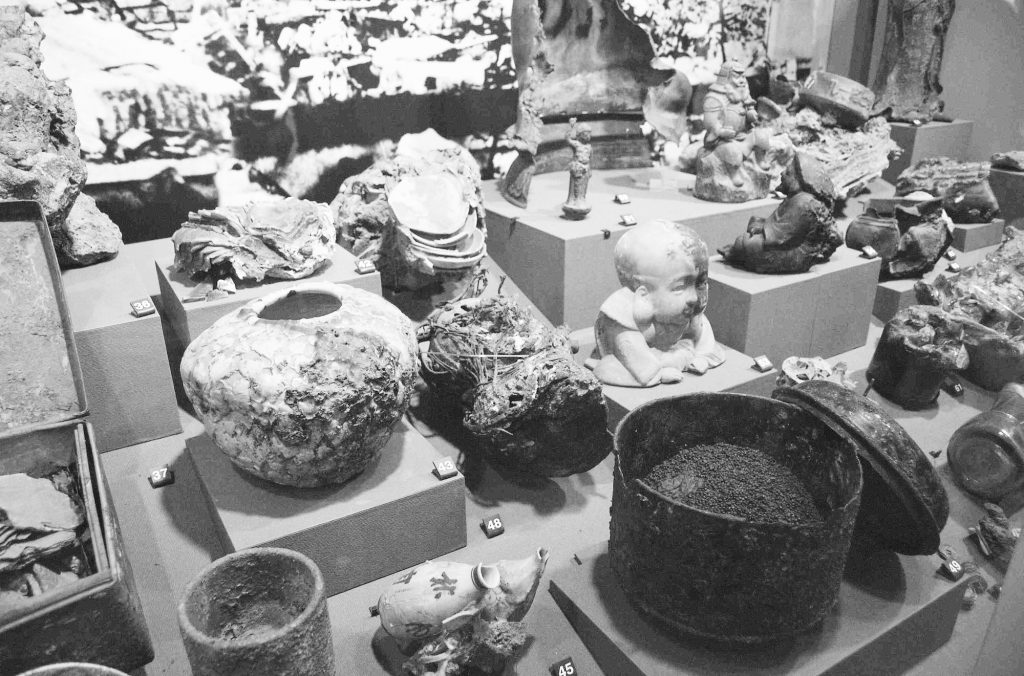
Hiroshima bomb artifacts at the Hiroshima Peace Memorial Museum (Photo: Courtesy of Rob Buscher)
Visiting the Hiroshima Peace Memorial Museum was naturally an overwhelming experience. Yet, beyond the immense sadness and anger I felt in those moments that such an atrocity had been perpetrated by the country of my birth on my family’s ancestral home, my lasting impression of that day was the feeling of hopefulness that the memorial service evoked.
Afterwards, attendees had the opportunity to write a message of peace on paper lanterns that were launched on the river later that evening. I will forever remember the soft glow of the thousands of floating lanterns as they drifted down the Motoyasu River.
As an American, I will likely never understand the complex emotions that hibaachan felt when facing the memories of her past. Nor can I fully appreciate the strength and resilience of our Hiroshima relatives who lived through this horrific experience. But I am immensely proud to be a descendant of Hiroshima, and hope that one day we may live in a world without nuclear weapons.

